Coccidiose em Pequenos Ruminantes - UTL Repository ...
Coccidiose em Pequenos Ruminantes - UTL Repository ...
Coccidiose em Pequenos Ruminantes - UTL Repository ...
You also want an ePaper? Increase the reach of your titles
YUMPU automatically turns print PDFs into web optimized ePapers that Google loves.
Abstract<br />
Coccidiosis in small ruminants<br />
Coccidiosis is a parasitism caused by parasites of the subclass Coccidia. Nevertheless, the<br />
term is used, generally, to refer to parasitism caused by parasites of the genre EimeriaThere<br />
is a great number of species of Eimeria which present a great host specificity. The<br />
pathogenecity depends on the species and few are considered pathogenic enough to, just for<br />
th<strong>em</strong>selves, cause clinical manifestations of the disease. However the infections usually<br />
involve several species and regularly assumes a subtle form that only becomes evident in<br />
the infected animals after the occurrence of clinical signs, such as diarrhea, debility and<br />
weight loss, leading to important economical losses.<br />
Coccidiosis has its bigger impact in lambs with less than three months of age and it is<br />
common in goat kids in the first six months. It is more common in intense production<br />
syst<strong>em</strong>s, being influenced by many aspects, amongst which, and most important, the<br />
handling practiced in the explorations. E. crandallis and E. ovinoidalis are considered the<br />
more pathogenic species in sheep and in goats it is E. ninakohlyakimovae. Two studies were<br />
carried out during the training period. The first one had the purpose of evaluating the<br />
prevalence of Eimeria spp. in Portuguese sheep farms in extensive, s<strong>em</strong>i-intensive and<br />
intensive syst<strong>em</strong>s, selected by non probabilistic methods. In this study it was concluded that<br />
the intensive syst<strong>em</strong>s presented a higher percentage of infected animals, being the single<br />
infections more frequent in intensive explorations and mixed infections more frequent in the<br />
extensive ones.<br />
E. bakuensis was the prevalent species in the three syst<strong>em</strong>s of production. E. ovinoidalis,<br />
one of the more pathogenic species, was more frequent in intensive explorations. The<br />
second study pretended to analyze the level of excretion of oocistos of Eimeria spp in kids<br />
between three and thirteen weeks of life in two distinct syst<strong>em</strong>s of production (in Portel and<br />
in Igrejinha), In the Portel farm the kids were fed by their dams and in the Igrejinha farm they<br />
were fed artificially. The results showed that E. caprina and E. christenseni presented<br />
excretion values of oocistos, superior in the Portel exploration. The total Eimeria spp. oocysts<br />
excretion excretion reached the maximum value at thirteen weeks, age in which E. arloingi,<br />
E. caprina, E.caprovina, E. christenseni and E. hirci reached the maximum medium values of<br />
excretion of oocyst. Amongst these, E. arloingi, presented the higher values.<br />
Key words: coccidiosis, Eimeria spp., prevalence, manag<strong>em</strong>ent, production syst<strong>em</strong>.<br />
v


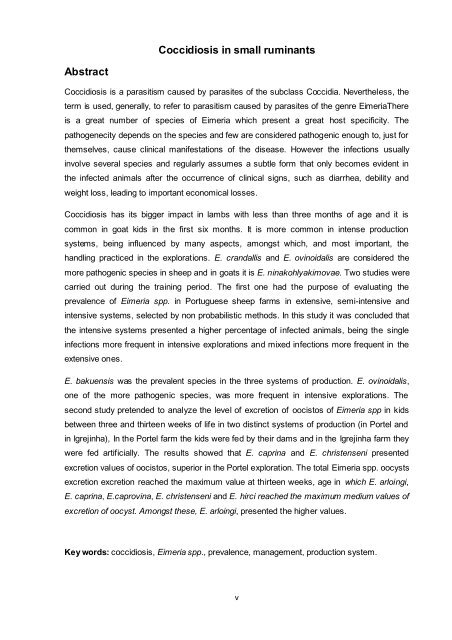
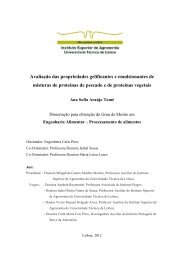
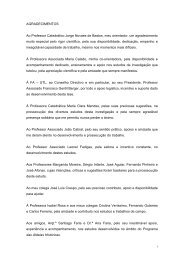

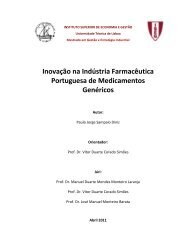
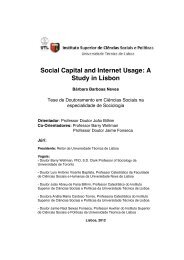
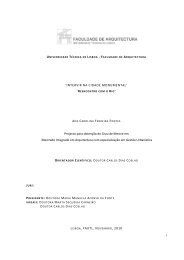
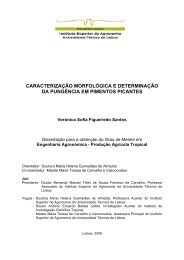

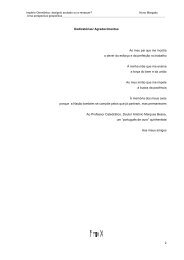
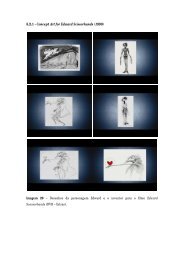
![Tese - Es..[1].pdf - UTL Repository - Universidade Técnica de Lisboa](https://img.yumpu.com/25707135/1/184x260/tese-es1pdf-utl-repository-universidade-taccnica-de-lisboa.jpg?quality=85)


